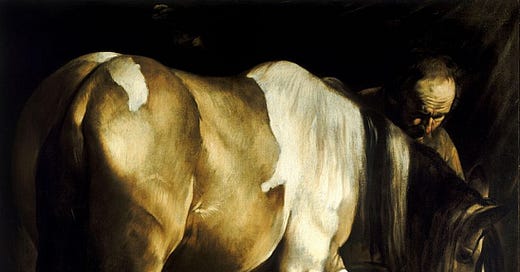Caravaggio’s Saul Fallen From the High Horse He Rode In On
An ekphrastic poem for today's feast of the Conversion of St. Paul, January 25
We see the horse’s rear before we notice Saul.
Many in his time judged the scene vulgar.
Moderns delight in its quirky originality.
In baroque exaggeration, the horse
Ridiculously maybe cynically
Dominates the picture plane,
With one upraised hoof,
Another lower, two hooves planted firm
Muddled in part-shadow with the legs of Saul
And the bare legs and feet of an old groom.
Can anyone find the rest of Saul’s right leg?
And if he was riding, where’s the saddle?
Perhaps versimilitude was not the point?
Foreshortened, Saul's head projects from the frame
His helmet rolled off, his sword at his side.
The young Saul not yet pointy-bearded Paul
All righteous breathings-out, and threatenings
Intentions of slaughter against Christians
Knocked out of him—while his merciful Teacher
Unseen by horse and groom and us, forgiving
As first martyr Stephen prayed He would
Fills Saul with the good news His Messiah has come.
O Saul, my Saul, why do you persecute Me?
Dear Jesus, I thought you my people’s enemy.
Saul lies eyes closed, face calm, arms upstretched with
Fingers splayed, heart open, embraces the Divine
In Light that streams in from somewhere—maybe
From behind and above our right shoulders.
-------------------
NOTE: The above version shortened by the removal of the first three stanzas from last year's version, shown below, based on input from Dana Gioia. Which version do you prefer, if either? Comments are welcome.
JANUARY 25
THE CONVERSION OF ST. PAUL
Caravaggio’s Saul Fallen
Beneath the High Horse He Rode In On
Some time along the history of paintings of Saul's conversion
Some painter added a horse that wasn’t in the Bible
And others took up that convention
Michelangelo for one, Raphael for another,
Then Durer etched an enormous horse and a smaller one
In prints disseminated and admired by tout le monde.
Fifty years later, unconverted brawler Caravaggio
In his Conversion on the road to Damascus
Appears to have merged both of Durer's horses
Into a horse and groom of his own imagining.
The horse ridiculously and maybe cynically
Huge and with one foot raised
and its other three legs muddled with
the legs of fallen Saul and the legs of the groom.
We see the horse’s rear before we notice Saul.
Many closer to Caravaggio’s time saw the scene as vulgar,
Moderns delight in its unconventional indisputably original
Caravaggesque light and dark and theatrical force.
Caravaggio shows us the young Saul not-yet-bearded Paul
All breathings out and threatenings and intentions
Of slaughter against Christ's disciples knocked out of him.
Saul, Saul, why dost thou persecute Me?
Oh my dearest Lord, I thought you were the enemy.
Saul lies eyes closed face calm arms
Stretched up, hands open, reaching
To embrace the True Light—while a revelation
Invisible to horse and groom is
Infusing in him everything he needs to know.
Saul who fell prostrate a zealous Pharisee
Breathing curses against blaspheming Christians
Rose again blind for a time but a believer
Who in an instant Jesus had taught to see.
An Apostle to the Gentiles called out of time.
Terrifying witness to the Jews
Who remembered his persecuting zeal
Before he fell. Before he rose again.




From email:
Well, you did take out those verses for a reason so the shorter version is the best. DW